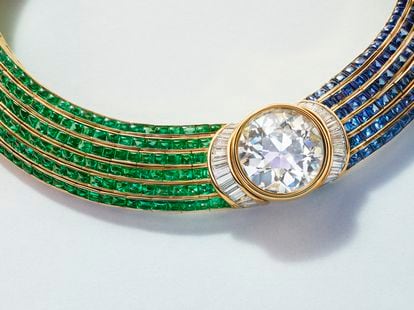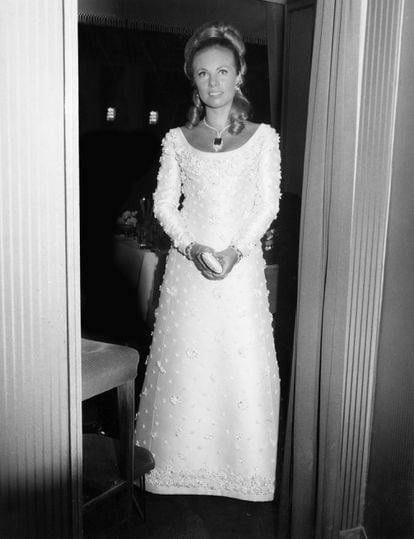Lope de Vega wrote in his play, La Circe (1624): “Que la sombra de un hombre poderoso / claro en linaje / mil delitos cubre” — That shadow of a powerful man / clear in lineage / covers a thousand crimes. Centuries later, Honore de Balzac would express a similar sentiment: “Behind every great fortune lies a great crime.” So, what delinquency lies behind Heidi Horten’s private collection of jewelry that was to go under the hammer at Christie’s in May in Geneva? Horten, who died last year, was an art collector and philanthropist who became the richest woman in Austria with a fortune of $3 billion, according to Forbes, thanks to the money she inherited in 1987 from her husband, Helmut Horten, a German businessman and owner of the Horten AG department store chain, who also belonged to the Nazi party and amassed his wealth during World War II.
Heidi Horten met Helmut when she was 19 and he was 51, but the age difference did not stop them from marrying six years later. It was thanks to the money that she inherited on Helmut’s death that Heidi was able to acquire what is now the largest collection of jewelry ever to be sold by Christie’s, with pieces including unique creations by Cartier, Harry Winston, Boivin and Van Cleef & Arpels , as well as an important selection of pearls, jade and Bulgari creations from the 1970s, 1980s and 1990s. Her jewelry box even came to hold Marie Antoinette’s pearl, which the Austrian heiress bought in 2018 at a Sotheby’s auction for the record sum of $36 million.

“Horten created a very sophisticated collection, combining antique and modern designs from the world’s leading jewelry houses,” says Rahul Kadakia, a jewelry expert at Christie’s. The sale of the collection is expected to exceed $150 million, a record-breaking sum for the auction house. Only twice has a sale made more than $100 million, namely when Elizabeth Taylor’s jewelry collection went under the hammer in 2011, and, later in 2019, when pieces from Indian royalty were sold.
Among the jewels from Horten’s collection are the so-called Briolette of India, a 90-carat diamond necklace made by Harry Winston and originally sold by Cartier in 1909; also in the lot is the so-called Grand Mogul, another pendant necklace by Harry Winston, but in this case fashioned from emeralds and valued at between $500,000 and $700,000. These two necklaces are joined by dozens of brooches, jade earrings and rings such as the so-called Sunrise Ruby, a 25-carat Cartier piece in pink, valued at between $15 million and $20 million.
Christie’s will present 400 of the 700 jewels in two live auctions at the Hotel Des Bergues in Geneva on May 10 and 12, and in a parallel online sale between May 3 and 15, with another auction to be held in November.
The anticipation regarding the sale has led to a preview tour of the most important pieces throughout the month of April in cities such as Hong Kong, Shanghai, Vienna, New York, London and Singapore. The proceeds from the auction will go to the Heidi Horten Foundation to fund medical research and other philanthropic activities as well as the maintenance of the museum of modern and contemporary art that the billionaire widow opened in Vienna on June 9, 2022, just three days before her death. “A completely unexpected death,” the museum said of Horten’s demise at the age of 81 at her home on Lake Wörthersee in Austria.
A private art gallery shrouded in controversy
Jewelry was not the only piece of art collected by Horten, who married more than twice after being widowed in 1987. In the 1990s, she began acquiring modern and contemporary art. The $1 billion she inherited from her husband in 1987 put her on the Forbes list of the 500 richest people in the world and allowed her to expand the couple’s existing art collection, adding pieces by Joan Miró, Pablo Picasso, Henri Matisse, René Magritte, Marc Chagall, Jean-Michel Basquiat and Andy Warhol. Her first two acquisitions would be a work by the painter Moïse Kisling and another by Emmanuel Mané-Katz, bought at an auction in Tel Aviv in 1994.
In 2018, Horten decided to team up with the Leopold Museum in Vienna and present 170 works from her private collection in a temporary exhibition that was called WOW! The Heidi Horten Collection, focusing on American expressionism and pop. That first contact with the art circuit prompted the heiress to pursue one of her dreams and set up her own museum, which was, however, steeped in controversy due to the actual source of her immense fortune. To try to placate the critics, she commissioned a report on her husband’s business activities, which concluded that while the magnate took advantage of Nazi policy by acquiring property from plundered Jewish fortunes at rock bottom prices, he hadn’t been actively involved in the plundering himself.

“I am proud, with my collection and the construction of the museum, to have created something lasting, which future generations will also be able to experience when they visit my museum and take joy in the art that has given me such joy for so long ,” Horten said. The statement was subsequently uploaded in a post on the gallery’s official Instagram account on February 13, on the occasion of what would have been Horten’s 82nd birthday.
Horten’s gallery boasts a collection of more than 500 works in a 16,000-square-meter historic building in the heart of Vienna, between the State Opera and the Albertina museum, which the collector acquired and refurbished for around $30 million. “It is the museum created by a woman who built a fantastic collection in the last 35 years that is now among the 200 most important in the world,” Agnes Husslein-Arco, director of the Heidi Horten Collection, said prior to the inauguration. It is a collection whose first pieces were bought in another historic auction at Sotheby’s in 1996 when, in the space of a few hours, the heiress spent up to $22 million, acquiring pieces by Francis Bacon, Pierre-Auguste Renoir and Paul Klee. It is a sum that may also be spent by bidders on her jewelry this time round at Christie’s.
Sign up for our weekly newsletter to get more English-language news coverage from EL PAÍS USA Edition
